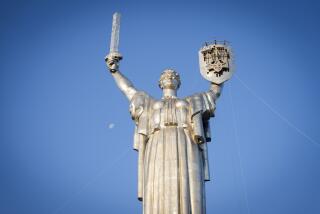Eagle Replaces Russian Hammer, Sickle : Emblem: President Yeltsin decrees two-headed czarist symbol to be nationâs new seal. Experts predict controversy.
MOSCOW â Liquidating one of the last symbols of the Soviet past, President Boris N. Yeltsin has officially replaced the hammer and sickle with the two-headed eagle as the seal of the new Russia.
The eagle, whose two heads face East and West, has been a symbol of the Russian czars since the 15th Century.
But in todayâs fractious, chaotic Russia, the birdâs two heads may unwittingly represent a nation divided over whether a symbol of monarchy and empire is appropriate for a fledgling democracy.
âItâs going to be controversial,â historian Roy A. Medvedev said of the presidential decree published Wednesday. âWe absolutely need a new symbol, because nobody is proud of the old one. . . . I understand the desire to return to old traditions, but this must be done carefully, since people donât want to return to the 19th Century.â
The Yeltsin government has been trying to do away with the hammer and sickle, the Soviet symbol that glorified labor and the union of workers and peasants.
But the conservative Parliament that Yeltsin has since disbanded repeatedly rejected the czarist eagle.
As a result, Yeltsinâs decree making the two-headed eagle the symbol of the new Russian state is printed on presidential stationery that bears the hammer and sickle and communismâs most famous slogan: âWorkers of the world, unite!â
âThe complete set of Soviet Communist ideology is present on this very document,â presidential spokesman Anatoly A. Krasikov said.
Yeltsinâs decree, signed Tuesday and published Wednesday, is a temporary measure until ratified by the new legislature, to be elected Dec. 12 and known by the pre-revolutionary name of Duma.
But some of the mammoth hammers and sickles that adorn Moscow are already headed for historyâs scrap heap.
The big golden emblem on the damaged White House Parliament building was the first to go. The double-headed eagle is to be mounted on key government buildings by Jan. 1, according to the decree.
The golden two-headed eagle was in use as early as the 7th Century BC, in Egypt, and later was the emblem of the Byzantine Empire. Russiaâs Czar Ivan III adopted it after marrying the niece of the last Byzantine emperor in 1472.
Since then, the eagle has been revised as many times as the map of Russia.
The version published by Yeltsin on Wednesday looks most like the one used by Peter the Great.
Yeltsinâs eagle, like Peterâs, is pictured with three crowns, an orb in one claw and a scepter in the other.
According to a statement released Wednesday by the presidential press service, these monarchist trappings no longer have royalist or imperialist overtones.
The three crowns can be taken as symbols of the executive, judicial and legislative branches of power, the statement said.
The scepter, once the symbol of a military commander, now means protection of Russiaâs sovereignty, and the orb is a symbol of the unity and integrity of the state.
On the eagleâs breast is the image of St. George slaying a dragon--the traditional herald of Moscow.
Gone are the eight shields that once symbolized the czarâs imperial possessions, including Finland and Poland. And the new eagle wears a less ferocious expression than did its ancestors.
In current form, âitâs not an imperial symbol, itâs a purely Russian symbol,â Medvedev said.
Still, in a state struggling to define its post-Communist identity, the resurrection of the Romanov eagle stirred mixed emotions Wednesday, more than 70 years after the overthrow of the last czar.
Yelena V. Vladykyna, 77, thought of relatives who died fighting for the Bolshevik cause.
âThey were fighting against the restoration of that evil eagle that meant poverty and slavery for us simple people,â she said. âAnd now it is all coming back.â
But a 20-year-old student greeted the move with relief.
âAnything is better than that stupid hammer and sickle,â said Andrei A. Chumakov. âAn eagle can fly high.â
Sergei L. Loiko of The Timesâ Moscow Bureau contributed to this report.
More to Read
Sign up for Essential California
The most important California stories and recommendations in your inbox every morning.
You may occasionally receive promotional content from the Los Angeles Times.










